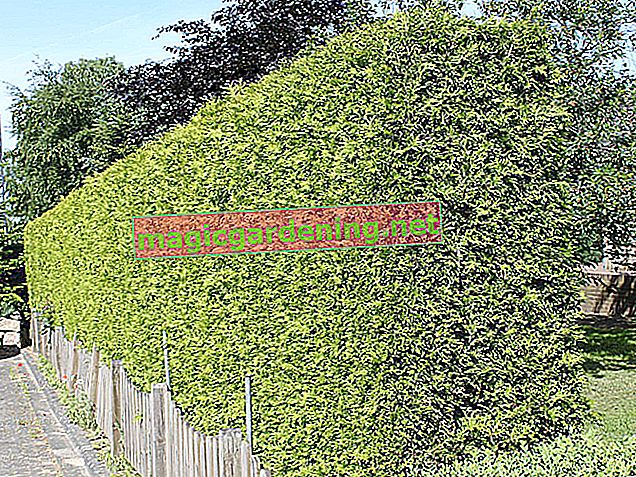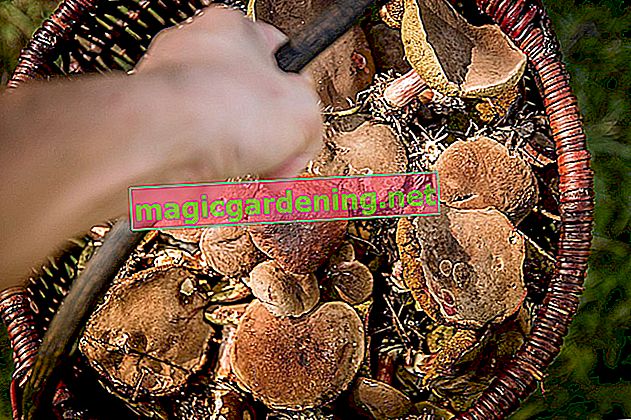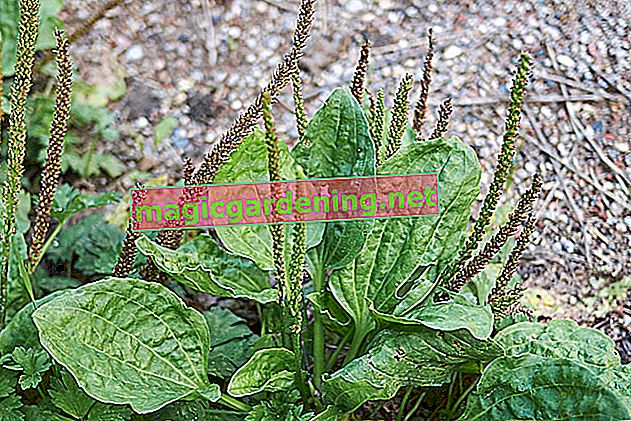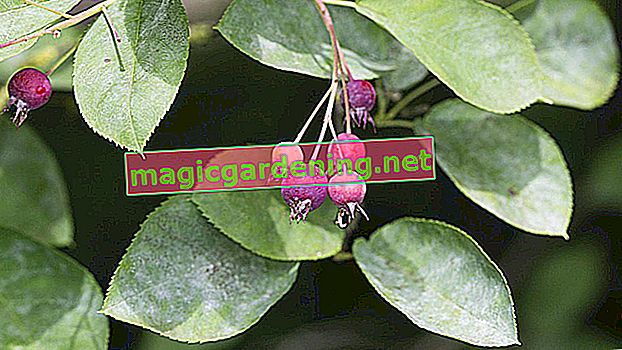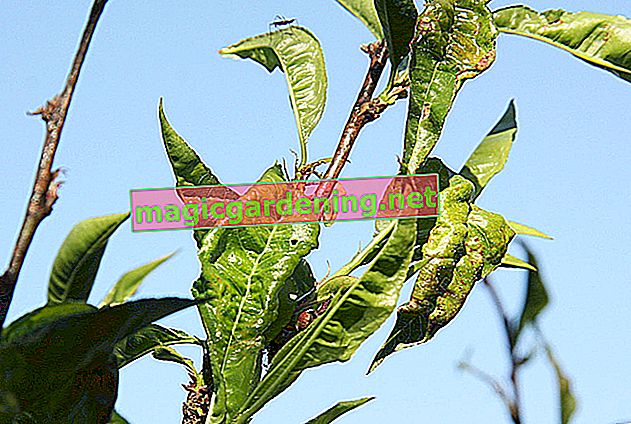
the essentials in brief
- Aqueous solutions with milk or horsetail have a preventive effect against the curl disease. Vinegar is sprayed in winter, while baking soda is used to swell the buds.
- To ensure that the plant survives an infestation well, accompanying measures are useful. Choosing the right location ensures a high level of resistance.
- The curl disease occurs with a typical damage pattern mainly on peach and nectarine. Curled leaves on other plants suggest different causes.
Home remedies that help against frizziness
If the fungus has settled in the leaf tissue, no countermeasures will help. You can only remove the affected leaves to encourage the tree to sprout again. Effective crop protection can be sprayed the following year before the buds begin to swell.
also read
- The ripple sickness in the nectarine tree
- Harrow Beauty peach resistant to frizz disease
- Combating peach curl disease

| Period | phase | medium |
|---|---|---|
| November to February | Hibernation | Milk, horsetail, vinegar |
| February to March | Bud swelling | Milk, horsetail, baking soda, copper lime |
| March to April | Shoot and growth | Milk, horsetail, baking soda |
Year-round anti-fungal agent: milk

Whole milk contains fungicidal ingredients and has been shown to be effective in the fight against powdery mildew. Regular spraying can have a positive effect on an infection with the frizz disease. Milk changes the environmental conditions and deprives the fungal spores of their livelihood. Mix milk with water in a ratio of 1: 1 and treat buds, shoots and leaves with the solution once a week. The infestation cannot be completely combated, but you can create a fungus-inhibiting environment with regular spraying.
For plant strengthening: horsetail
Field horsetail contains silica, which has a supporting effect on leaf tissue and cell walls. Collect the herb in August, as this is the time when the active ingredient content is highest. Pour ten liters of water over one kilogram of fresh herb and let it steep for 24 hours. Then boil the brew for half an hour. Sieve off the coarse parts of the plant and spray the affected trees with a diluted solution in a ratio of 1: 5.
How to use field horsetail:
- year-round use as a plant-strengthening casting agent
- spray on the plant in case of acute infestation
- use as a preventive spray in winter
Preventive home remedy: vinegar
According to EU regulation 2015/1108, vinegar can be used as a fungicide. The agent has a caustic and anti-fungal effect, and should be injected undiluted as a preventive measure. Avoid using solutions with soap, as this neutralizes vinegar and makes the substance ineffective. Put the liquid in a spray bottle and spray the wood between November and February. Make sure that the furrows in the astrial bark and buds are well moistened, because this is where the fungal spores overwinter.
For agriculture only: copper spray
When the buds swell, spraying with copper lime proves to be effective. This happens between February and March, when temperatures rise above ten degrees Celsius. Applications are already possible from five degrees to effectively prevent the growth of the spore cells. Sprays with copper are not approved for combating frizzy diseases in private gardens. You should therefore use commercially available and approved plant protection products.
YoutubeIn the event of an infestation: baking soda
Soda dissolves in water with a weakly alkaline reaction. This makes the raising agent valuable when used against fungal diseases on plants. Powdery mildew and gray rot can be treated biologically with baking soda and the agent can also have a negative impact on the living conditions for the fungal spores in the case of curl disease. The pH value changes so that the growth of the spore cells is restricted.
The recipe to imitate:
- Mix one liter of water with two to three dashes of alcohol
- add some washing-up liquid
- Scatter a packet of Bach powder
Accompanying measures
The preferred woody plants can only be infected in spring when the weather is mild and rainy. For this reason, a sunny and airy location is recommended, where the fungus does not find optimal living conditions. A later infection is not possible because the fungus has a special life cycle and lasts for most of the year.
First aid in the event of an infestation:
- Attach glue rings to the trunk
- prevent further weakening by aphids
- Rain protection on cool days with temperatures below 16 degrees
- adequate watering on hot days
- regular nitrogen fertilization
- Thinning of the fruit
background
Fungal spore life cycle

Taphrina deformans feeds exclusively on dead plant material from June to February and poses no danger to fruit trees and woody plants during this time. From the end of February the fungus develops numerous sprout cells that are washed into the opening buds with the spring rain. They infect the freshly sprouting leaves and grow through flower buds as soon as the thermometer rises above eight degrees Celsius.
After the leaves of the first shoot fall off as a result of the disease, the trees sprout again between June and July. The fungus is no longer infectious above 16 degrees. It hibernates on the shoots and on the scales of the newly formed buds until the next spring.
Choosing the right location
Plant trees on a south-facing wall so that they get enough sun. An overhanging roof protects against rain during the critical months of late winter. If you cannot guarantee roof protection, you should protect the tree from moisture with a tarpaulin during the main infection season. Remember to remove the cover for ventilation on sunny days. You can stop the measure from temperatures of 16 degrees.
Once the frizziness has broken out, the course of the disease can hardly be stopped. The correct location deprives the fungus of the growth conditions.
Plants often affected
Taphrina deformans is a fungus belonging to a genus with parasitic fungi that spread mainly on ferns and dicotyledonous plants. They do not kill the host tissue, but rather deform the infected parts of the plant. Like its relatives, the fungus responsible for frizziness has specialized in certain species. This means that the species is not always responsible for curled leaves on plants.
Common causes of curled leaves include:
- Cherry: aphids
- Apple tree: apple powdery mildew, fruit tree spider mite, apple aphid
- Currant: currant aphid, currant leaf gall, red currant gall mite
- Pear: pear leaf sucker, floury pear aphid
- Tomatoes: care errors, tomato rust mites, spider mites
- Roses: sawfly, rose aphid
- Cherry laurel: aphids, powdery mildew
Digression
Attention risk of confusion
If the eye is inexperienced, viewing terminal curled leaves can quickly lead to a misdiagnosis. In summer, such deformed foliage shows up even after an insect attack. However, pest infestation by aphids and other sap-sucking insects is not preceded by red blisters, which are typical of the infectious curl disease in the early stages. With a close look at the underside of the leaf, you can quickly determine whether leaf pests were at work.Prunus persica

The leaves of the peach tree and nectarine tree become infected early in the year as soon as the buds begin to swell. If you notice the typical symptoms, remove stunted shoots and fruit mummies. These should be disposed of with household waste to prevent the disease from spreading. Biological spraying makes sense at the end of January. The product “Neudo-Vital Fruit-Mushroom Protection” from Neudorff has proven itself. Repeat the spray three to four times over the coming weeks.
Strains that cope well with frizz disease:
- Nectarine : 'Snow Queen', 'Flavortop', 'Independence', 'Nektarose'
- Plate peach : 'White Frisbee', 'Yellow Frisbee'
- Peach : 'Fruteria', 'Benedicte'
To prevent the fungal disease, you should plant all sensitive varieties of dwarf nectarine, flat peach or dwarf peach in the correct location and thin out the crown regularly. It helps to provide peach trees with long-term mineral or organic fertilizers. That makes the trees more resistant. Regular spraying with field horsetail tea helps prevent infection. To protect the plants, it is advisable to plant under them with horseradish, nasturtiums or garlic.
Tips
Lime milk serves to protect the tree bark from frost and diseases. The aqueous solution with the milk-like consistency can also be used for spraying. It reduces the risk that the fruit tree will be attacked by the curl disease.
Prunus armeniaca
Although the apricot is not one of the preferred host plants of Taphrina deformans, the woody plant in the suboptimal location is occasionally affected by the fungal disease. The spores spread in damp, mild weather and penetrate the open buds. Planting in the right location is therefore the first step in preventing infection.
Recognize frizziness in apricots:
- young leaves curl and develop light green to reddish spots, slightly raised
- Leaves rotate around their own axis as the disease progresses
- Foliage turns whitish and appears rubbery before falling off
How to recognize frizziness

The symptoms show up in spring after damp and mild weather. As a result of the disease, the leaves die off. If the tree is strong and healthy, it will withstand the fungal attack and replace the fallen leaves with healthy leaves in summer. Old and severely weakened trees can die from the disease.
| Leaf shape | Leaf coloring | |
|---|---|---|
| Initial stage | ruffled | occasional light green or red blisters |
| Middle stage | knotted and thickened | reddish or light green to whitish |
| Terminal stage | greatly enlarged, rubbery to brittle | increasingly darker |
As soon as the first deformed leaves are visible in April, the fungus has already settled in the tissue. The affected foliage falls off in June, so that a severe infestation can result in damage to the baldness. A strong rubber flow is characteristic of the curl disease. Fruits are rarely attacked. If the tree is weakened by the disease over several years, it can die.
Tips
If you spray the buds with an ecological paint spray in winter, you can watch the timing of the swelling closely. The paint will then crack and peel off. It is at this point that you should take plant protection measures.
Consequences of an illness
If the tree had to shed almost all of its leaves, there is a reduction in the overall photosynthesis output. If the fungal attack is widespread, the branches die off completely. Trees weakened in this way reduce their flowering, so that the harvest yield also decreases. The effects are often still noticeable in the following year, because bud growth is also restricted after the disease.
frequently asked Questions
Can I eat the fruit if the curl disease affects them?
The disease extremely rarely extends to the fruits, so your harvest can only be endangered by the consequences of the disease. When the leaves are crinkled and fall off, the tree lacks a lot of leaf surface for photosynthesis. As a result, it can throw off unripe fruits or let them not ripen properly. The small peaches are still suitable for consumption because they are not contaminated by fungal spores.
My peach tree is so infested with the curl disease that every single leaf becomes heavily knotted and I fear a crop failure. What to do?
Whether you can still save the harvest depends on various factors. Some varieties prove to be resistant and regenerate comparatively quickly after an infestation. Age also plays a role in recovery, because young trees get better faster than old trees. Carefully remove the infected leaves and pick fruits from the crown that no longer appear healthy. It is quite possible that the trees will look very bare afterwards. Spray the tree with horsetail broth and with a little luck, fresh and healthy leaves will sprout after a while and the fruits will be preserved.
Are there any strains that are resistant to frizz disease?
In general, white-fleshed peaches are less sensitive to the fungal disease than yellow-fleshed or reddish varieties. However, do not trust any advertising promises of completely resistant peaches and nectarines. So far there is no variety to which the fungus cannot spread. However, many cultivars prove to be less sensitive or survive an infection better than other cultivars. These are tolerant peach varieties:
- white flesh : 'Fidelia', 'Amsden', 'Roter Ellerstädter'
- yellow-fleshed : 'Alfter's record'
- red flesh : 'vineyard peach'
Does my plum tree have curl disease?
If your plum shows curled leaves, it is not the causative agent of the curl disease but a leaf pest such as the plum aphid. Taphrina deformans has specialized in certain trees and only affects peach, nectarine and almond trees. A related parasitic fungus from the same genus is mainly targeting the species Prunus domestica with all its varieties and cultivars. This also includes mirabelle and plum trees. Taphrina pruni is responsible for pocket disease and is less likely to cause deformed and crooked leaves and shoots.



